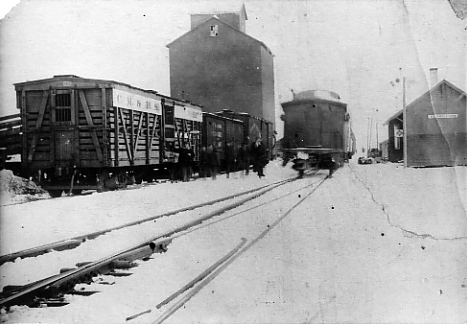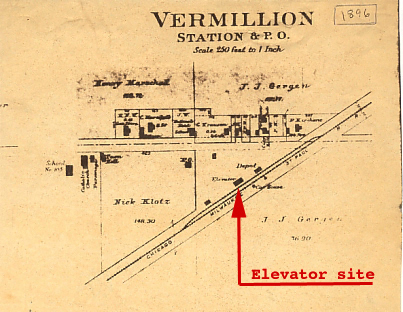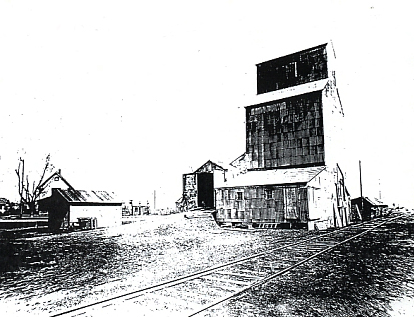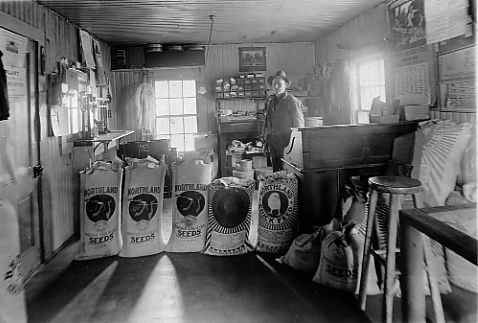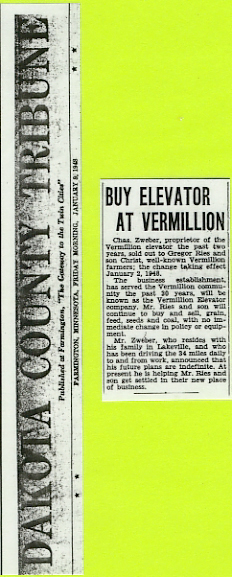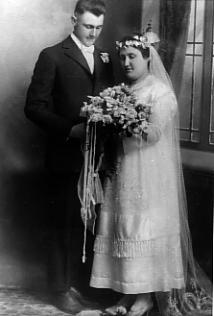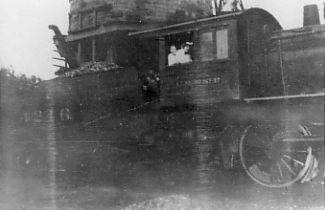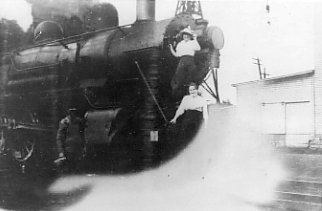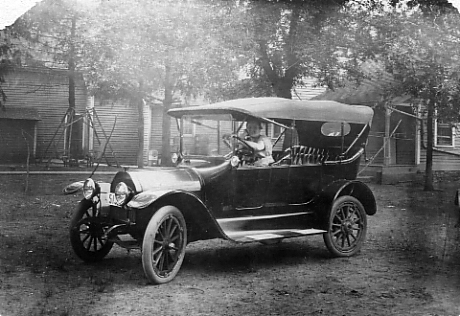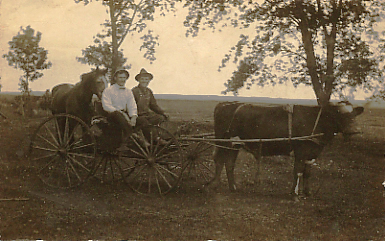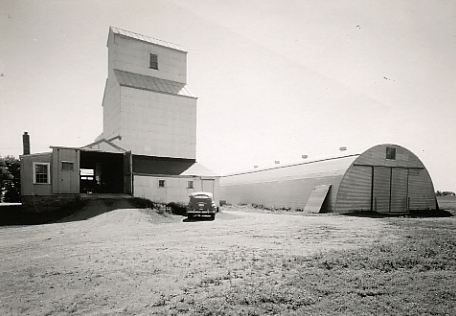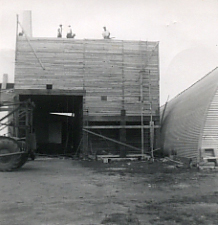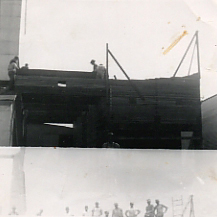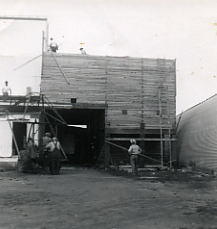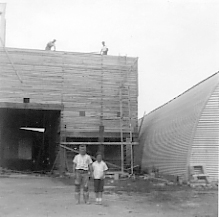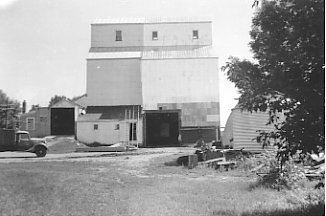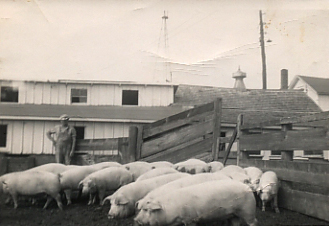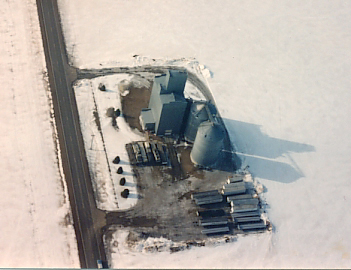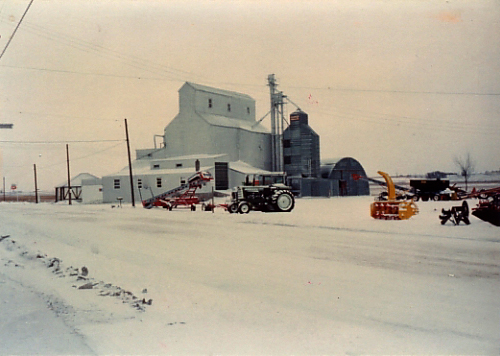| A history of harvest Vermillion Elevator's roots run deep | VERMILLION'S first elevator was built in 1869 by Albert Rickert. A small establishment powered by a blind horse, it was constructed alongside the Chicago, Milwaukee, St. Paul and Pacific Railroad and shipped grain to various parts of the country. Rickert later sold the business to Wallerius and Thompson. They, in turn, sold the building to a local farmer, who used it as a barn.
The first elevator built on the site of the current elevator was constructed in 1875 by E. I. Stowell. Construction began in the late summer of 1874, but the project encountered a temporary delay when a heavy August storm blew down the frame. Built of wood, the structure was one and a half stories high and had a capacity of 5,000 bushels. Because there was no electrical power at the time, horses were used to elevate the grain.
Not surprisingly, the elevator was constructed next to the railroad track that ran on the south side of the city, ensuring that grain could easily be loaded into boxcars and hauled to Hastings, Farmington and other cities. The first railroad in Vermillion was the Hastings and Dakota. Completed in 1866, it consisted of the track and a platform where settlers could gather when the locomotives rolled into town, steam whistles blowing. About four years after the railroad opened, it was purchased by the Chicago, Milwaukee, St. Paul and Pacific Railroad. Sometime after 1881, a depot was constructed just east of the elevator and a telegraph installed. But, over time, improved roads, bigger semi-trailer trucks and poor railroad management combined to choke the life out of rural railroads. Today, the only visible sign of the Chicago, Milwaukee and St. Paul is the long-abandoned railroad bed, which still can be spotted by observant farmers as well as pilots flying low and slow between Vermillion and Hastings.
In 1876, a year after he built it, Stowell sold the elevator to Adam Reiger, who operated it until 1880, when he leased the building to Kellogg and Lange. During this period, Levi Westfall, who came from Waverly, N.Y., was in charge of daily operations. Business was booming: during the previous year, the elevator shipped more than 200,000 bushels of wheat, plus oats, barley and corn, the Hastings Gazette reported on Sept. 15, 1880. Wheat was such a prevalent crop back then that some early news articles referred to the Vermillion elevator as the "wheat elevator."
In January 1884, Jacob Rieger purchased a half interest in the elevator for $2,000, forming a partnership with his brother, Adam. A week or two later, the elevator caught fire and burned. At the time, it held about 2,000 bushels of wheat, 600 of them owned by area farmers. Wheat saved from the flames was sold as chicken feed to area farmers, including J. F. Colby, who bought 164 sacks. By the end of February, Martin Webster was awarded a contract to rebuild the elevator. Framing was completed by early March and, by June 1, the new elevator was taking in large quantities of wheat and shipping it to various cities out east.
In January1885, Adam Rieger traveled to Hastings to purchase lumber for a 20-foot by 40-foot addition to the elevator. But things didn't work out and, in March, the Riegers dissolved their partnership. Adam took sole control of the business.
At this point, the elevator's history becomes a bit murky. The Sept. 26, 1891, issue of the Hastings Gazette reported that Smith & Thompson built "a large addition to their elevator at Vermillion Station, owing to the large quantity of grain now being marketed there." While news accounts back then often referred to the city of Vermillion as Vermillion Station, it's possible this story refers to another elevator, the one built in 1873 by D. S. Bach in what is now the city of Empire. Initially called the Auburn Elevator, it was two stories high, 20-feet by 40-feet in dimension, with a capacity of 10,000 bushels. The elevator was sold in 1879 to William Thompson. His partner, J. A. Smith, also owned an interest in the Hampton elevator. According to a history of Dakota County published in 1881, Thompson continued to own the Auburn Elevator but it was not operating at the time the history was written.
A couple of years later, J. A. Smith died and his interest in the Hampton elevator was sold to Bat. Steffen of Hastings, while his interest in the Vermillion elevator was sold to E. N. Wallerius of Vermillion.
A news item published in the May 15, 1897, Hastings Gazette deepens the mystery. "The Hastings Malting Company will ship grain from Vermillion Station, having engaged Christoph Bauer, of that town, as buyer. They expect to build an elevator there by the time the new crop is ready for market." Does that mean that at one time Vermillion had two elevators? Not likely, but read on.
In March 1893, a group of Vermillion area farmers met at the town hall to discuss the possibility of organizing an elevator company. By the end of the meeting, they had elected Jacob Kummer as president of the new organization; V. F. Rother, secretary; E. N. Wallerius, treasurer, and J. J. Gergen, manager. The directors were Peter Stoffel, J. P. Brochman, J. P. Girgen, Jacob Kummer, V. F. Rother, E. N. Wallerius and J. J. Gergen. The final sentence in the article is intriguing: "It was decided to either buy one of the elevators there or build a new one." Notice that the writer didn't say "the elevator," but rather "one of the elevators." Again, the plural reference could have been to the Vermillion elevator and the Empire elevator, both of which were in Vermillion Township.
A month later, the Gazette reported that the newly organized farmers' elevator company in Vermillion bought the grain elevator from Hastings Malting, for $4,750. The new owners were to take possession by May 1st.
In June 1894, the Vermillion Farmers' Elevator Company held its first annual meeting in Vermillion. The company reported a net profit of $605.81. "The business of the first year is certainly very gratifying, and it would be amusing if not startling to know just what the actual profits were to the farmers of the eastern part of the county since the organization of these elevators," the Gazette article states. "The success of the company is largely due to the sagacious steadiness of their manager, J. J. Gergen, considering the difficulty of a neighboring market he had to contend with. That the company appreciated his work was shown by re-appointing him for another year at an increased salary." The "neighboring market" reference most likely was to the elevators in Empire and Hampton rather than to a possible second elevator in the city of Vermillion. That belief is bolstered by the fact that at least four life-long residents of the Vermillion area say they never heard of anyone mentioning two elevators in Vermillion.
A year later, in July 1905, J. J. Beissel was elected manager of the Vermillion elevator and, a month later, P. J. Wiederhold was hired as assistant manager. In January 1906, V. F. Rother was named the elevator's new manager. In 1907, the elevator paid $20 in taxes; the following year, the tax bill climbed to $22.61.
In March 1908, J. J. Gergen bought the elevator at auction for $6,525. "He is an experienced man in the business and will undoubtedly do well the coming season," the Gazette said.
On July 4th, 1913, the elevator was struck by lightning during a holiday celebration and it burned to the ground. By this time, J. J. Gergen was in partnership with Christ Wagner, former owner of Wagner's Tavern, the forerunner of Kieffer's Tavern. The Gazette reported that the loss was partially insured.
"For three years, Vermillion was without an elevator," Mary Jane Fasbender wrote in a Sept. 13, 1935, article published in the Hastings Herald. Fasbender later married F. J. "Rusty" Peopl, prominent Vermillion banker. "In 1916, Bultman and Werner started the present elevator, but after three months the former left Minnesota and Mr. Werner became owner," Fasbender wrote. Bill Bultman was J.W. Werner's brother-in-law
According to the Hastings Gazette, construction of the new elevator began in January 1916 and was completed in early May.
"It is reported that Vermillion is to have a new elevator and lumber yard, marterial being delivered by rail," the Jan. 15, 1916, issue of the Gazette said. In its May 6, 1916, edition, the Gazette said, "The new elevator at Vermillion has been completed and was opened up for business Thursday, the first load of grain received in the afternoon."
John W. Werner, the elevator's new owner, witnessed numerous changes during his tenure. For instance, in her 1935 article, Fasbender reported that the Werner elevator was "equipped with an automatic air dump, a Carter disc separator, an automatic loading scale and a ten ton Fairbank's receiving scale." Werner also sold Minneapolis Moline farm equipment out of the elevator. In 1923, electricity was brought into Vermillion, enabling Werner to replace the gasoline engine with electric motors to power the equipment. Finally, railroad service to Vermillion ceased, prompting Werner to have a loader built at Empire so that he could haul grain there in trucks and then load it into Great Western Railroad boxcars.
Greg Ries, one of the elevator's current owners, says signs of the 1913 fire are still visible in some areas of the current structure's basement. He also said much of the equipment mentioned in Fasbender's 1935 article still exists, or was recently discarded. What's more, a major portion of the horse-powered elevating equipment used prior to the addition of the gasoline engine is still in place or is being stored elsewhere.
John Werner operated the business until April 1946, when he sold it to Charles Zweber of Lakeville. However, he continued to sell Minneapolis Moline equipment and, in 1948, formed a partnership with his nephew, Ernest Werner, and opened Werner Implement, a farm implement company that featured Minneapolis Moline tractors. Werner Implement continues to thrive today, owned and operated by Ernest Werner's two sons, Melvin and Charlie.
According to news accounts at the time, Zweber planned to add a warehouse and install a sheller, grinder and mixer. But Zweber operated the elevator for a relatively short time, selling it in January 1948 to Gregor Ries and his son, Chris, two-well known farmers who lived in the community. The new owners changed the name to Vermillion Elevator.
It's of interest to note that Gregor Ries was married to the former Theresa Wagner. Her father, Christ Wagner, once owned Wagner's Tavern, which later became Kieffer's Tavern. It closed a few years ago and recently re-opened as Duff's on Main. In addition, Christ Wagner was part-owner of the elevator before it burned down in July 1913.
For years, Gregor and Theresa Ries operated the elevator while their son Chris farmed and hauled grain to terminals ranging from the Twin Cities to Chicago. While Gregor operated the machinery -- he was particularly proud of the feed mixer -- Theresa ran the business, using her sharp mind and equally sharp No. 2 lead pencil to keep extremely accurate track of feed purchases and grain sales. Although only five feet tall on a good day, Theresa was a force to behold.
In 1958, a new 30,000-bushel addition was constructed on the south side, tripling the elevator's capacity to 45,000 bushels. The 12-bin, 30-foot by 42-foot addition was 60-feet high and contained 12 bins. The building was constructed by Jake Bauer, a well-known and highly respected contractor who built scores of barns and homes in the area.
In 1975, Gregor and Theresa sold their share of the elevator to their son, Chris, who became sole owner. Chris took charge of the machinery and continued hauling grain while his wife, Eleanor, did the bookkeeping. To keep up with the growing demand from area farmers, Chris constructed a much larger and more modern elevator in Vermillion Township, about a mile east of the old elevator. The foundation for the 150,000-bushel structure was poured in 1977 and the contractor, Hoganson Construction Company of Minneapolis, had about 25 semi-truck loads of lumber hauled to the site. While a growing number of new elevators were being constructed of concrete back then, Ries told a reporter that he selected wood because it was less expensive. Total cost of the project, which was completed in 1978, was $400,000.
To celebrate the new elevator's completion, Christ and Eleanor Ries hosted an open house at the nearby Kountry Korners hall. The invitation published in the Hastings Gazette made special mention that farmers should bring along their wives. Besides providing food and beverages, the Ries family also provided guests tours of the large structure.
During this time, their youngest son, Greg, was working at the elevator with his parents, mastering the machinery and the intracacies of grain marketing as he gradually assumed more responsibility for day-to-day operations. Chris Ries died in 1993. That same year, the elevator was incorporated, with Greg and his brother, Gary, as owners. Their mother, Eleanor, died in 1995.
In 1998, Carol, Gary, Judy and Greg Ries hosted an open house to celebrate the 50th anniversary of the family's ownship of the elevator. The party was held in the parking lot of the new elevator. Hundreds of friends, neighbors and customers came to share in the festivities. A large tent housed the music and beverages, while the food, including five roasted hogs, was served in a hall-like room in the adjacent warehouse. Kids were entertained with rides in a train-like series of carts pulled behind a John Deere garden tractor.
Today, the Vermillion Elevator stands as a monument to the changing landscape of agribusiness. When the elevator was founded more than a century ago, the Vermillion area was dotted with small farms powered by humans and horses. The main crop was wheat, followed by oats, barley and corn. Virtually every farmer back then had a small herd of dairy cows, some steers, a pen of hogs, a flock of laying hens and a large garden. A typical farm covered 160 or 240 acres. While wheat is seeing a recent resurgence, the main crops today are corn and soybeans. Farms consist of many hundreds, if not thousands, of acres. There are only two dairy farms left in the township, hog farmers are a rarity, only hobby farmers raise chickens and most produce is grown by Hmong vegetable gardeners. But despite these monumental shifts in agricultural practices, the Vermillion Elevator continues to thrive because it has evolved to meet the changing needs of its customers, from hauling and marketing tens of thousands of bushels of grain to furnishing high-quality grass seed for a 5,000-square-foot shady area in the backyard. Whether you are a farmer, a homeowner, a hobby farmer, a vegetable gardener or heat your home or shop with corn, the Vermillion Elevator is the place to shop. Please check out the rest of our Web site and click here to let us know what you think. --The staff at Vermillion Elevator
 |
| ||
| Copyright ©
Vermillion Elevator, Inc. All rights reserved.
| ||||
